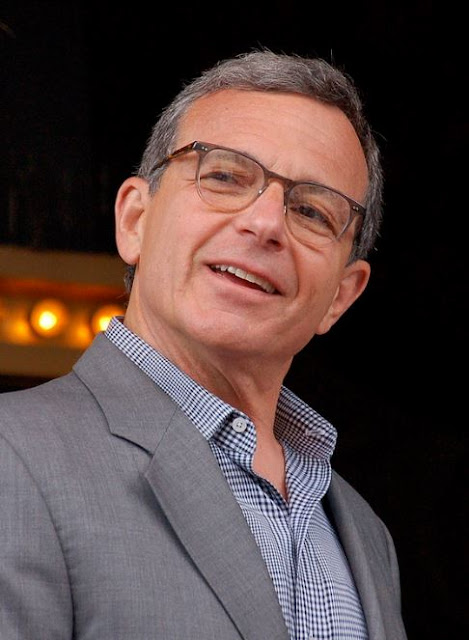The Ride of a Lifetime by Robert Iger
Lessons Learned from 15 Years as CEO of the Walt Disney Company
"There have been difficult, even tragic, days. But for me this has also been, to steal from a phrase, the happiest job on earth."
THE RIDE OF A LIFETIME
A grand vision defined: The CEO of The Walt Disney Company shares the ideas and values he has used to reinvent one of the most beloved companies in the world, and inspire the people who bring the magic to life.
In 2005, Robert Iger became CEO of The Walt Disney Company during a difficult time. Morale had deteriorated, competition was more intense, and technology was changing faster than at any time in the company's history.
Twelve years later, Disney is the largest, most respected media company in the world counting Pixar, Marvel, Lucasfilm and 21st Century Fox among its properties. Its value is nearly five times what it was when Iger took over, and Iger is recognized as one of the most innovative and successful CEOs of our time.
In The Ride of a Lifetime, Robert Iger shares the lessons he’s learned while running Disney and leading its 200,000 employees. The book includes everything from starting at the bottom, chronicling his beginnings at ABC, betting on new talent, planning for the future, leading with fairness and communicating principles clearly.
This book is about thoughtfulness and respect, and a decency-over-dollars approach that has become the bedrock of every project and partnership Iger pursues, from a deep friendship with Steve Jobs in his final years to an abiding love of the evolving Star Wars myth.
 |
| Shanghai Disneyland (Courtesy of Capricorn Song, Unsplash) |
The book opens in June 2016, with Robert having made his fortieth trip to China in the past eighteen years. He was to open Shanghai Disneyland, which he states “was the biggest accomplishment of my career.” The park had cost a whopping $6 billion to build. At 963 acres, it was eleven times the size of Disneyland.
He goes on to say, “We held casting calls in six cities in China to discover the thousand singers, dancers, and actors who perform in our stage and street shows. Over the eighteen years, it took to complete the park, I met with three presidents of China, five mayors of Shanghai, and more party secretaries than I can remember.”
This gives an idea of the scale of Shanghai Disneyland and the enormity of the work involved by Robert and his team at Disney.
In the early evening of June 12th, Robert received news of the mass shooting that occurred at Pulse nightclub in Orlando, close to Disneyland. They believed that Disney World could have been the perpetrator’s target. This was devastating news, and with Robert in Shanghai at the time, he states, “I felt horror and grief for the victims of the shooting.”
With well over 200,000 employees working around the world for Disney, when tragic events like this occur, Robert says in his book, “the odds aren’t insignificant that one of our people has been touched by it.” By Tuesday morning in Shanghai, they learned that two of their part-time employees were among those killed in the nightclub shooting.
Not long after this, with Robert still in Shanghai, gearing up for the biggest event in his career, he received news of another tragic event, “There was an alligator attack in Orlando.” He soon learned that a young boy had been attacked, was missing, and that rescue teams hadn’t yet found the body. The boy’s name was Lane Graves.
It was opening night in Shanghai, and the story was being reported widely at that point. Robert insisted that a statement come from him, and not someone else on his team. He writes, “I’ve seen other companies deal with crises by letting a “company spokesperson” be their official voice, and that strategy has always struck me as cold and a bit cowardly.”
Robert released a statement and spoke directly with the Lane’s family. He also called on his team to make changes to the park so that nothing like this could ever happen again.
In the introduction of the book, Robert goes on to say, “I went off to meet dignitaries. We rode rides and posed for pictures. I struggled to smile and go on with the show. It was a stark example of the truth that what people see on the outside so often doesn’t reflect what’s happening on the inside.”
The reason I included this part of the intro was because I thought about just how deeply affected Robert must have been and how he was able to convey that through his writing. Here he was, the biggest moment of his career, struck by two huge tragedies within days of each other. As CEO, he wanted to deal with them directly, but also states, “you trust your people to do their jobs.”
His hope with his book is that the stories and examples he shares will help others in leadership positions feel more concrete and relatable, as well as less fearful and more confident.
Although the book talks mostly about Iger’s career in chronological order, there’s a brief part at the beginning that discusses his family life and upbringing. He thanks his dad for making him curious about the world. Growing up, he had a den lined with shelves full of books, with his dad having read every one of them. Robert didn’t become a serious reader until high school, but eventually he fell in love with books, and owes that to his dad, too. He talks about his dad’s manic depression, and the several therapies he’d tried, including electroshock therapy.
“As the older child, I bore the brunt of his emotional unpredictability. I never felt threatened by his moods, but I was acutely aware of his dark side and felt sad for him. We never knew which Dad was coming home at night, and I can distinctly recall sitting in my room on the second floor of our house, knowing by the sound of the way he opened and shut the door and walked up the steps whether it was happy or sad Dad.”
I absolutely love that Robert brings up Jiro Dreams of Sushi in the book. It’s one of my favourite documentaries, and it’s so nice to see Iger’s respect for Jiro. Robert loved the documentary so much that he showed excerpts of it to 250 executives at a Disney retreat. “I wanted them to understand better, through the example of Jiro, what I meant when I talked about “the relentless pursuit of perfection.” This is what it looks like to take immense personal pride in the work you create, and to have both the instinct toward perfection and the work ethic to follow through on instinct.”
I highly recommend watching Jiro Dreams of Sushi, it’s available on Netflix, and follows revered 85-year-old sushi chef, Jiro Ono, as he strives for perfection in his work. It’s incredibly inspirational.
 |
| Miniature park design, Walt Disney Imagineering studios |
Another thing I loved about the book was the mention of Walt Disney Imagineering. I’ve watched The Imagineering Story on Disney+, which I also recommend. Stating Imagineering in simple terms, Iger says, “it is the creative and technical heart of everything we build that isn’t a film or TV show or consumer product. All of our theme parks and resorts and attractions, cruise ships and real estate developments, all of the live performances and light shows and parades, every detail from the design of a cast member’s costume to the architecture of our castles emanates from Imagineering. It is impossible to overstate the creative and technical brilliance of Disney’s Imagineers.”
The Ride of a Lifetime was a fascinating read and inspirational book for anyone working in, or wanting to work in a leadership role. It’s also incredibly interesting for anyone who adores Disney and wants a look behind the scenes. Robert’s story is a show of stunning achievement. The book has incredible depth, taking the reader to all areas of the business. The Ride of a Lifetime truly lived up to all expectations I have. It reads well and is engaging from start to finish.
 |
| Courtesy of Wikipedia |
Robert Iger was the executive chairman of The Walt Disney Company and directed the company’s creative endeavours. He served as CEO from 2005 to 2020. He previously was president and COO from 2000 to 2005. Iger began his career at ABC in 1974, and as chairman of the ABC Group he oversaw the broadcast television network and station group, managed the cable television properties, and guided the merger between Capital Cities/ABC, Inc., and The Walt Disney Company.



